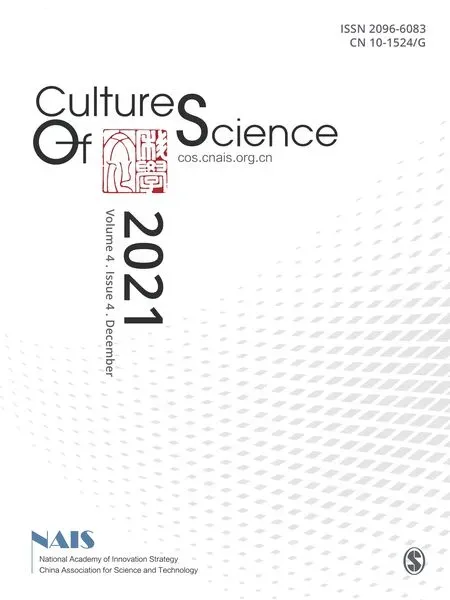Chinese scientists’ awareness of,attitudes to and involvement in open-access publishing
2021-03-18YangxuLu
Yangxu Lu
Chinese Academy of Science and Technology for Development,China
Yandong Zhao
Renmin University of China,China
Lei Huang
Chinese Academy of Science and Technology for Development,China
Abstract‘Open access’ is an important part of the open science movement and a significant change to the existing model of academic publication.Based on data from a large-scale survey of Chinese scientists,this paper describes their awareness of,attitudes to and involvement in open access.Policy recommendations on promoting open access in China are proposed at the end of the paper.
Keywords Open access,attitude,involvement,Chinese scientists
1.Introduction
‘Open science’ is a new trend in the global production and dissemination of scientific knowledge.The concept of‘freedom,openness,cooperation and sharing’championed by open science has fundamentally overturned the paradigm of scientific development and changed the relationship between science and society (Fecher and Friesike,2014;Vicente-Saez and Martinez-Fuentes,2018).Open access(OA)is an important part of the open science movement and a significant change to the existing model of subscriptionbased payment.Under the OA model,knowledge producers pay for the publication of their papers,and the publications are then provided freely to all readers,which makes it easier for the public to access knowledge.In recent years,the OA movement has made substantial advances and gained increasing understanding and acceptance in China (Zhang,2015).
Scientists are among the most important actors in the ongoing OA movement,and their attitudes and needs will have a decisive impact on the practice and development of OA.The results of surveys in other countries show that scientists from developed countries in Europe and the US have richer experiences in OA practices and hold more positive attitudes towards OA.1It is important to note that the rapid development of OA formats may have accompanying problems,including a perceived lower quality of OA journals,high article-processing costs and an increased financial burden on research institutions and scientists.As a result,there is still much controversy about OA.
The data used in this study came from a survey on Chinese scientists’ attitudes towards and involvement in open science.The survey was organized by the National Natural Science Foundation of China(NSFC)and conducted by the Chinese Academy of Science and Technology for Development in 2020.A random sample of 85,628 scientists was drawn from all applicants to the NSFC in 2018.Each sampled scientist was sent a link to an online survey.A total of 12,253 samples were collected.The response rate was 14.3%.
Based on the data collected in the survey,this paper seeks to establish the perceptions and attitudes of Chinese scientists regarding OA and systematically analyses the behavior and needs of scientists publishing articles in OA journals.
2.Chinese scientists have a high awareness of OA
2.1.Most scientists have heard of OA
According to the survey data,25.1% of the Chinese scientists‘have heard of and know about’ the concept of OA,and 45.7% have‘heard of but don’t know much about’ it.In other words,a total of 70.8% of the surveyed scientists have heard of OA.Figure 1 shows the differences among different groups in their awareness of OA.Respondents from universities and research institutes are more aware of OA:71.9% of respondents from universities and 69.9% of those from research institutes have heard of it,which is a higher percentage than for respondents from medical institutions (64.0%).The figures for respondents holding senior titles(74.7%) and associate senior titles (71.5%) are higher than those for respondents with intermediate and lower titles (66.1%).Male respondents have a higher awareness of OA than females:75.2% of male respondents have heard of the concept,and 31.0%say they know the concept quite well;the corresponding percentages among female respondents are 63.1% and 14.7%,respectively.Respondents from different disciplines also show some differences in their awareness of OA.For example,75.0% of respondents in chemistry have heard of OA,which is slightly higher than in other disciplines,such as mathematics and science(67.9%)and medicine (67.1%).

Figure 1.Awareness of OA among scientists.
2.2.‘Read the papers you need for free’is the most typical perception scientists have about OA
To further understand scientists’perceptions of OA,we asked:‘What implications do you think open access should have?’ The options included‘Readers can read the papers they need for free’,‘Authors pay a higher fee to publish papers’,‘Authors publish papers and keep them in a designated place’,‘The data related to the author’s published papers are stored in a designated place’ and‘Authors can publish papers as long as they pay the publication fee’.
Figure 2 shows the responses to the question.The proportions of the five options are 97.4%,55.8%,57.5%,62.1%and 17.0%,respectively.As the results suggest,there is a consensus that,under the OA model,‘Readers can read the papers they need for free’,and there is also a relatively high level of consensus on how papers and related data are stored.Noting criticism regarding the article-processing charges of OA journals,we included this factor in the options of our survey.Although many of the respondents did not equate‘open access’ with‘pay to publish’,nearly 60% believed that authors have to pay more to publish in OA journals.

Figure 2.Scientists’ perceptions of OA content.

Figure 3.Channels through which scientists learned about OA.
2.3.Internet and journal promotion are the main channels for scientists to learn about OA
Figure 3 shows the channels through which scientists learn about OA.According to the survey results,42.3% of the respondents first learned about it from the internet,and 37.2% learned about it from journal promotions.The role of other information channels,such as Chinese colleagues/friends (9.9%),domestic and international academic conferences (6.2%),foreign colleagues/friends (2.4%) and publicity by funding agencies (1.0%),is relatively limited.It is clear that,although different groups depend on different information channels to varying degrees,the internet and journal promotion are the two most important channels across all groups.
3.Chinese scientists have actively participated in OA
3.1.More than half of the surveyed scientists have published papers in OA journals
The survey showed that 99.0% of the scientists had published academic papers in the previous three years.Among them,44.8% said that they had published papers in OA journals,37.6% said that they had not done so,and 17.6% did not know whether they had or not.For those who knew that they had not published in OA journals or had not published any papers in the past three years,the survey asked whether they had published in OA journals before.Of them,21.3%said they had published in OA journals before,71.9% said they had not done so,and 6.8% did not know.Based on these figures,52.4%of the scientists surveyed know they have published papers in OA journals.2
Further analysis shows that there are notable differences among different groups regarding the experience of publication in OA journals.Scientists with higher professional titles are more likely to have published in OA journals:58.8%,51.0% and 43.4% for the senior title group,the associate senior title group,and intermediate and lower title groups,respectively.Of scientists with study or work experience overseas,56.1% have published in OA journals.In addition,among those who have published in OA journals,only 4.4%published before 2010,after which publication in OA journals gained popularity(Figure 4).
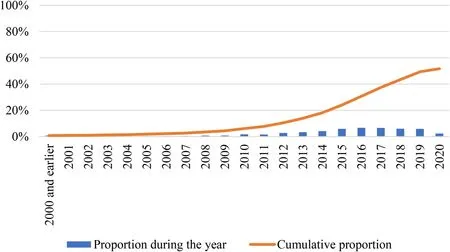
Figure 4.Years when scientists had their first publications in OA journals.
3.2.In the past three years,Chinese scientists published an average of 1.8 papers per person in OA journals
According to the survey,the average number of papers published by respondents in OA journals in the past three years was 1.8,with 1 as the median;the mean proportion of OA journal papers in the overall output of scientists in the past three years was 20.7%,with 9.9% as the median (Table 1).The average numbers of papers published in OA journals in the main disciplines include,in descending order,medicine (2.6),life science (2.3),information (2.0),mathematics and science (1.7),earth science (1.4),engineering and materials (1.4),chemistry(1.1)and management (1.1).
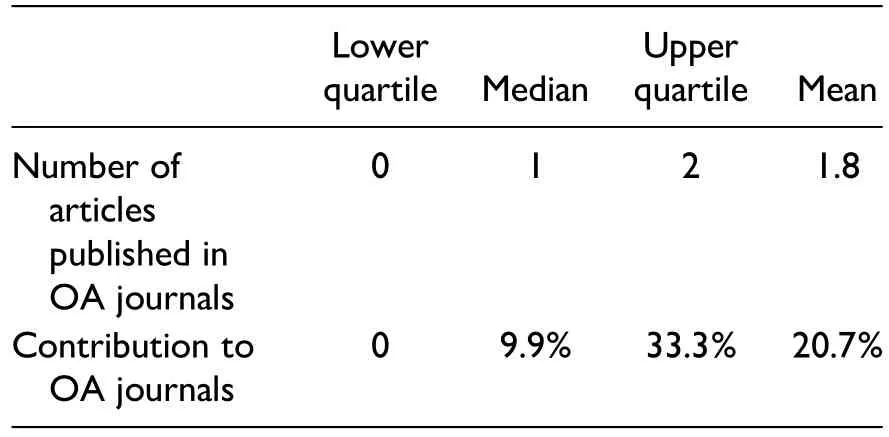
Table 1.Scientists’ publications in OA journals.
3.3.The average cost of publication in OA journals has exceeded 10,000 yuan,which is a financial burden on scientists
During the survey,we studied the costs for publishing papers in three types of journals in the past three years:English non-OA journals,Chinese non-OA journals and OA journals.We found that the publishing costs for OA journals are higher than those for non-OA English academic journals and even higher than those for non-OA Chinese academic journals.Specifically,30.6%of the respondents who had published English papers had not paid for the publication of their papers;8.2% of the respondents who had published Chinese papers had not paid for the publication of their papers;8.0%of the respondents who had published in OA journals had not paid for their papers.
Table 2 shows the mean and median costs,respectively,for the three types of publications:English academic papers 6635yuanand 4000yuan,Chinese academic papers 3750yuanand 3000yuan,and OA journals 10,430yuanand 10,000yuan.

Table 2.Page charges of different types of journal papers (yuan).
Further analysis shows that there are notable differences among different disciplines in the publication costs of OA journals:medicine (12,535yuan),life science (11,097yuan),information (10,057yuan),chemistry (9938yuan),earth science (9802yuan),engineering and materials (9153yuan),mathematics and science(8495yuan)and management(7020yuan).
We asked the respondents about their overall feeling about paying for publication in OA journals.Among the scientists who had not stated that they would not publish in OA journals in the future,13.4%felt that paying for publication in OA journals was very difficult,and 50.7% felt that paying for publication was somewhat difficult,which together account for 64.1%of the total;27.1%of the respondents had no problem with paying for publication,and 8.8% said they were not sure.
4.Chinese scientists’ attitudes towards OA publication
4.1.Wide impact,large readership and speedy publication are the most important features of OA journals
OA journals are the most important platform for carrying out OA activities.Compared with traditional academic journals,OA journals have a series of new features.In the survey,we asked the respondents about their views of such features.In the opinion of the respondents,the most prominent features included,in order of importance,wider social impact,larger professional readership,shorter publication time,higher citation rate,shorter review time,lower review requirements,lower paper quality and lower editorial and typographical standards (Figure 5).In general,the views of the respondents are mostly positive,but there were also negative comments.
4.2.Most scientists are willing to publish their papers in OA journals in the future
According to the survey,65.4% of the respondents indicated that they are willing to publish in OA journals in the future,8.1%indicated that they will not do so,and 26.6% are not sure.The willingness of Chinese scientists to publish in OA journals is somewhat higher than the willingness of their global peers.According to the 2019 Researcher Survey organized by Taylor &Francis Group,349.0% of the 2755 scientists surveyed worldwide plan to publish their work via OA in the next year.
Figure 6 shows the willingness of scientists to publish in OA journals.Applicants with lower professional titles are more willing to do so.The proportions of applicants with senior titles,associate senior titles,and intermediate titles and below who are willing to publish in OA journals are,respectively,61.9%,65.7% and 69.7%.The greater respondents believe their research ability to be,the less likely they are to publish in OA journals.The proportions are,respectively,59.0%,61.6%,63.4%,66.6% and 68.0% for those who believe their research ability is in the top 1%,top 5%,top 10%,top 20% and top 50% in China in their specific area of research.Those who have published in OA journals in the past three years are more likely to continue the practice in the future.The proportions of applicants who have indicated their willingness to publish in OA journals are,respectively,48.5%,58.1%,and 75.2% for those who have never published in OA journals,those who have published before but not in the past three years,and those who have published in the past three years.Discipline-wise,respondents’ willingness to publish in OA journals is highest in medicine (77.2%),life science(74.2%)and earth science(69.0%).
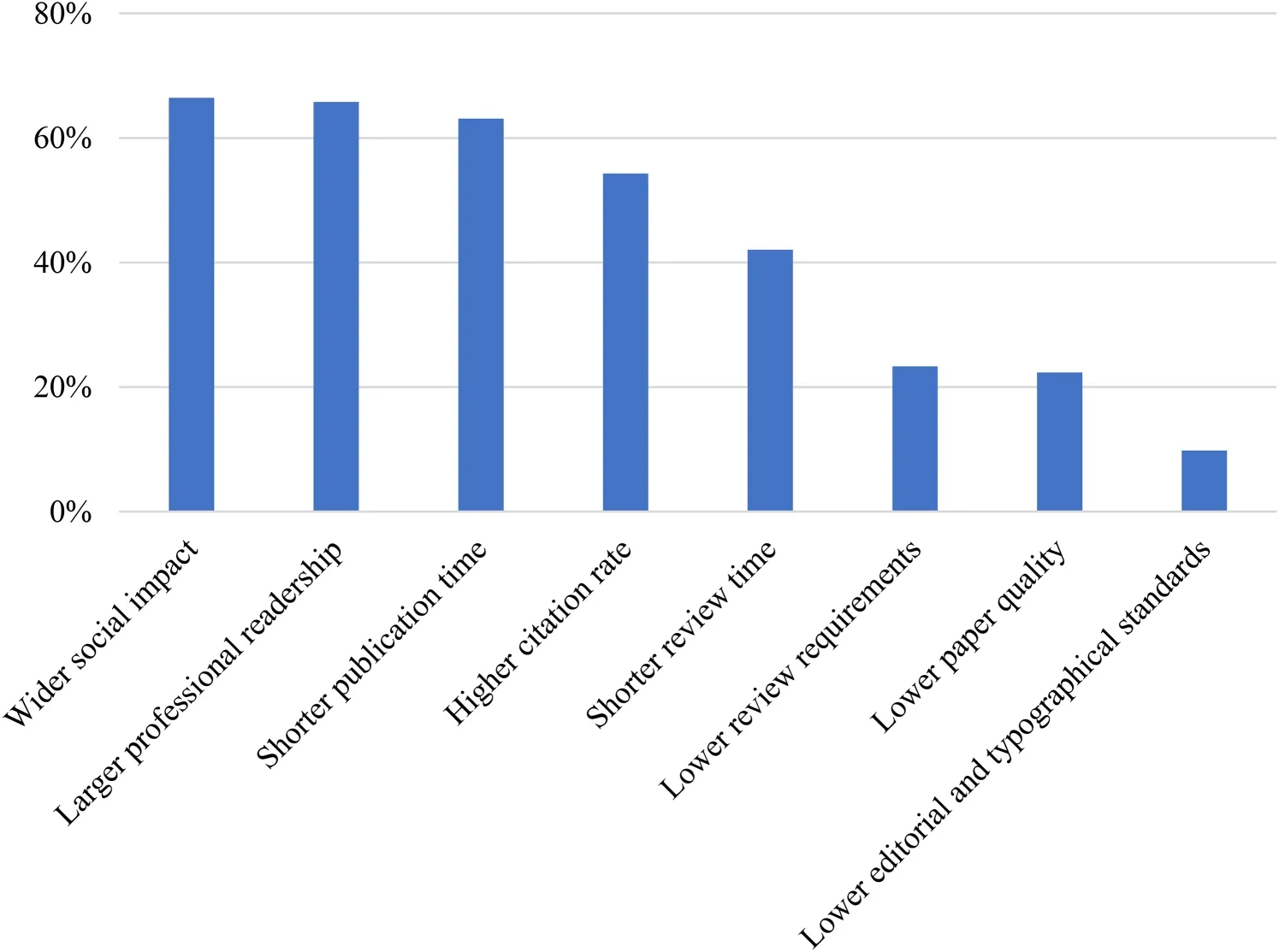
Figure 5.Scientists’ perceptions of OA journals.
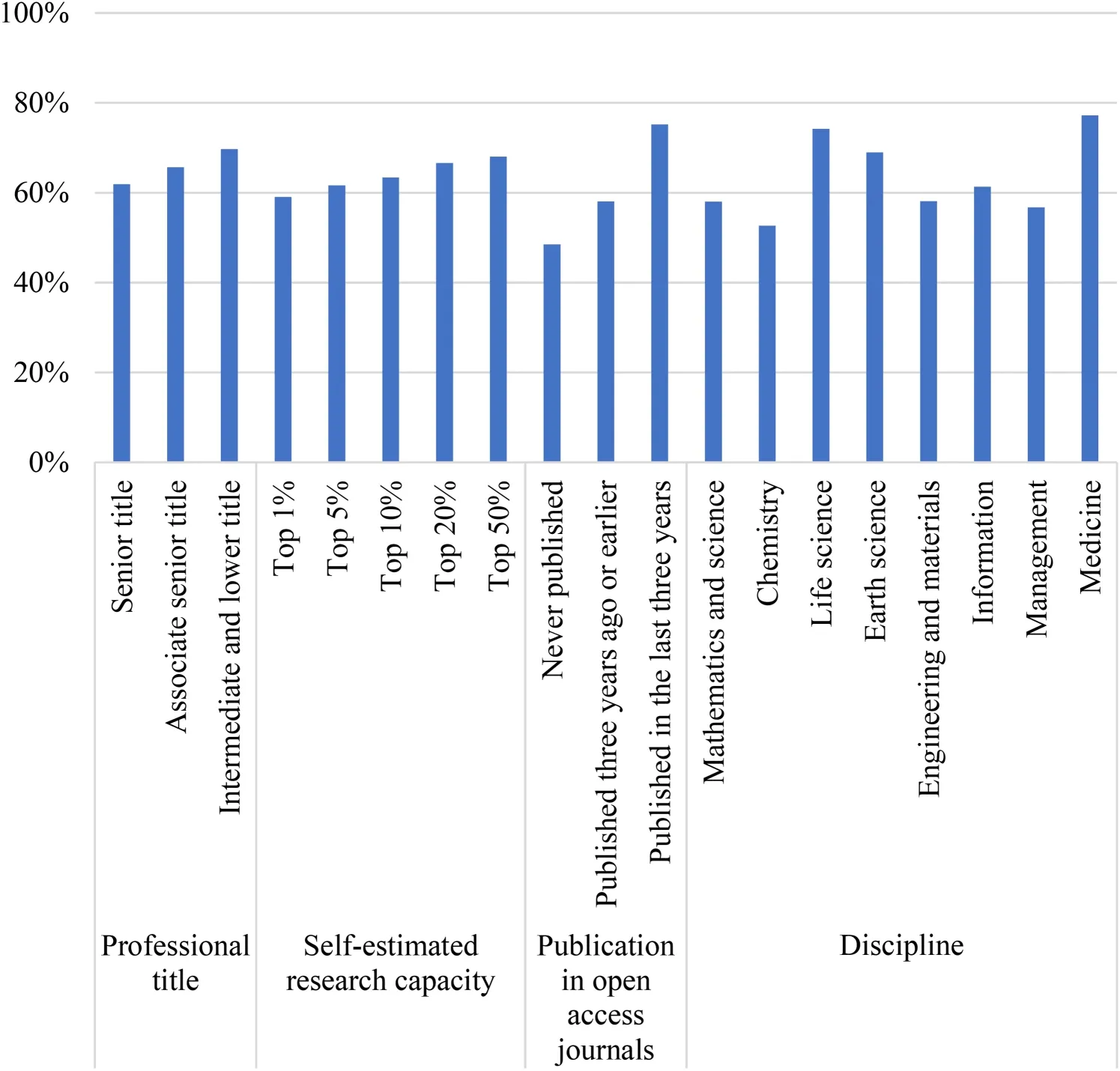
Figure 6.Willingness of different types of scientists to publish in OA journals.
4.3.High cost and low quality are the main reasons dissuading scientists from publishing in OA journals
By replacing the reader-pays model with the authorpays model,OA has increased the financial burden on research institutions and scientists in publishing academic papers.The quality of some OA journals is also widely criticized.To some scientists,‘OA’ is synonymous with‘low quality’.Among the scientists who said they were not willing to publish in OA journals,79.2% cited‘high cost of publication’ as the reason;80.5%of scientists aged 35 years or below and 82.3%of scientists aged 36–45 years cited‘high cost of publication’ as the reason.The proportions that cited the same reason were 70.4% and 74.1% for the 46–55 and 55+age groups,respectively.
Following‘high cost of publication’,the other two reasons cited by respondents are‘bad reputation of the journals’and‘lack of peer recognition of the journals’.Specifically,among the scientists who said they will not publish in OA journals,60.0%cited the bad reputation of the journals and 57.6%cited the lack of peer recognition of the journals.Scientists with higher research ability are more likely to cite the poor quality of OA journals as the reason.
5.Summary and policy recommendations
Based on the survey results,Chinese scientists have a relatively positive attitude towards OA and believe that it has a positive impact on their research.Chinese scientists have actively contributed papers to OA journals and are largely willing to continue to do so.However,the analysis also shows that the charges of OA journals are high,and the quality of the journals may need to be improved.We make the following recommendations.
First,fully understand the strategic significance of OA for actively integrating China into the international innovation network.Chinese scientists should actively participate in the discussion and formulation of international OA rules to better promote the global exchange of science and technology knowledge and to better preserve the environment for scientific progress.Science and technology departments should establish special committees responsible for the access to scientific data and information.
Second,establish a sound mechanism for open sharing of scientific and technological information and cultivate a culture of openness.Governments,science funding agencies and academic publishers should strengthen communication and promote the concept,model and policies of OA to research institutions and scientists through various channels.The government and science funding agencies should actively promote the construction of institution-based knowledge banks through financial support,assessment,evaluation and other means to establish standard and convenient OA procedures.It is also important to balance the relationship between openness and confidentiality,while supporting a culture of transparency,by increasing the disclosure of government information,exploring links of access to financial support,and other means.
Third,support the development of high-quality OA journals and explore multiple OA forms.Governments and science funding agencies should strengthen cooperation with academic publishers to select several high-quality OA journals.They should establish a welldesigned monitoring and evaluation index system for OA journals and further improve the early-warning system for‘predatory’ journals.The Chinese Government and scientific community should actively support the development of high-quality Chinese OA journals.
Declaration of conflicting interests
The authors declared no potential conflicts of interest with respect to the research,authorship and/or publication of this article.
Funding
The authors disclosed receipt of the following financial support for the research,authorship and/or publication of this article:This work was supported by the‘Major Innovation and Planning Interdisciplinary Platform for the“Double-First Class”Initiative,Renmin University of China’ sponsored by the National Natural Science Foundation of China (grant number L1824004).
Notes
1.See Taylor &Francis Group,2019 Researcher Survey,at https://authorservices.taylorandfrancis.com/researcher-survey-2019/.
2.0.524 ≈0.448 ×0.99+0.376/0.99 ×0.213.
3.See details at https://authorservices.taylorandfrancis.com/researcher-survey-2019.
杂志排行
科学文化(英文)的其它文章
- The theoretical origin of the knowledge-sharing mode of open access:From knowledge communism to academic capitalism
- Open science:Pursuing development through communication,cooperation and sharing
- An analysis of public-oriented science communication by Chinese research groups in the context of responsible innovation
- CloudRT:A Chinese example of open science infrastructure and services
- Open and inclusive science:A Chinese perspective
